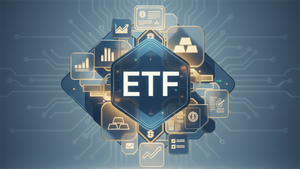
New York, NY – In a significant pronouncement for the financial world, JPMorgan (NYSE: JPM) has unveiled its highly anticipated 2026 stock market outlook, projecting a resilient landscape for global equities with annual returns hovering around 6-7%. Central to this optimistic forecast is the emphasized role of Artificial Intelligence (AI), which the banking giant views not merely as a fleeting trend but as a foundational, multi-decade productivity revolution poised to reshape corporate profitability and economic growth. This outlook signals a period of sustained, albeit slower, expansion for markets, urging investors to calibrate their strategies towards innovation and diversification.
The immediate implications of JPMorgan's forecast are substantial. It suggests that despite lingering macroeconomic uncertainties, the underlying health of the corporate sector and the transformative power of AI will underpin equity performance. For investors, this translates into a nuanced approach where strategic asset allocation and a keen eye on technological advancements become paramount. The report’s release on 11/10/2025 provides a forward-looking perspective, guiding market participants on potential trajectories for the next year and beyond.
Unpacking the Projections: A Detailed Look at JPMorgan's 2026 Outlook
JPMorgan's 30th annual Long-Term Capital Market Assumptions (LTCMAs) report serves as the bedrock for these projections, painting a detailed picture of the firm's expectations for the coming years. The report specifically forecasts global equity returns at approximately 7% annually. Delving deeper, U.S. large-cap equities are anticipated to yield 6.7% per year, while emerging markets equities are poised for even higher returns, projected at 7.8% annually. For a traditional 60/40 stock-bond portfolio denominated in USD, the expected annual return stands at 6.4%. Notably, JPMorgan suggests that a "60/40+ portfolio," which strategically incorporates 30% diversified alternatives, could achieve higher annual gains of around 6.9%, underscoring the increasing importance of broader asset class exposure.
The timeline leading up to this outlook is rooted in JPMorgan's consistent annual analysis of long-term market trends, reflecting a culmination of ongoing economic assessments, corporate performance reviews, and technological foresight. This year's report places an unprecedented emphasis on AI, recognizing its accelerating integration across industries. Key players involved in shaping and interpreting this outlook include JPMorgan's team of strategists and economists, global equity markets, and a vast array of investors ranging from institutional funds to retail participants. Initial market reactions, while still unfolding, lean towards a reinforcement of a "buy the dip" mentality, with some analysts anticipating the S&P 500 (INDEXSP: .INX) to "blast through" the 7,000 mark, driven by robust corporate earnings and fading economic headwinds. The report also highlights the continued momentum of retail investors, whose significant inflows into equity-based ETFs are expected to persist into early 2026.
Navigating the AI Wave: Potential Winners and Losers
The pervasive influence of AI, as articulated by JPMorgan, will undoubtedly create a distinct divide between market winners and losers. Companies that successfully embrace and effectively scale AI adoption to achieve tangible business results are poised for significant gains. This includes not only direct technology companies developing AI solutions but also firms across various sectors—from healthcare and finance to manufacturing and logistics—that leverage AI to enhance efficiency, innovate products, and optimize operations. These companies, by harnessing AI for productivity gains and competitive advantage, are likely to see increased profitability and investor interest, leading to stronger stock performance. Diversified portfolios, particularly those that include alternative assets, are also highlighted as potential winners, offering enhanced resilience and return potential in an evolving market. Furthermore, the report suggests expanded opportunities for skilled active managers who can adeptly identify and capitalize on the shifts brought about by new technologies.
Conversely, companies that are slow to integrate AI or fail to adapt their business models to the changing technological landscape could face significant challenges. Those relying on outdated operational frameworks or traditional growth models without a clear AI strategy may struggle to compete, potentially experiencing stagnant growth, eroding market share, and diminished investor confidence. Sectors that are resistant to technological disruption or lack the capital to invest in AI infrastructure could also be vulnerable. This outlook underscores a critical inflection point where technological agility and strategic investment in innovation will be key determinants of long-term success, potentially leading to a divergence in performance between AI-forward enterprises and their less adaptive counterparts.
The Wider Significance: AI as a Multi-Decade Productivity Revolution
JPMorgan's 2026 outlook transcends mere market predictions, fitting squarely into broader industry trends characterized by moderate global growth, renewed fiscal engagement, and rising economic nationalism. The report positions AI and advanced automation as a "multi-decade productivity revolution," a fundamental catalyst akin to past industrial transformations. This perspective implies that AI's impact will be far-reaching, fundamentally altering business processes, labor markets, and economic structures over the long term. This isn't just about a few tech stocks; it's about a systemic shift that will drive efficiency and innovation across nearly every sector of the global economy. The increasing deployment of technology is expected to drive both near-term profitability and sustained long-term productivity, with the stock market likely to feel the effects more profoundly than the debt market.
The potential ripple effects of this AI-driven paradigm are extensive. Competitors and partners across industries will be compelled to re-evaluate their technological strategies, leading to increased investment in AI research, development, and implementation. This could spark a new wave of mergers and acquisitions as companies seek to acquire AI capabilities or consolidate their positions in an AI-centric market. Regulatory and policy implications are also significant; governments may increasingly focus on developing frameworks for AI governance, data privacy, and ethical AI use, while also considering fiscal policies that support technological investment and manage potential job displacement. Historically, such technological revolutions—from the advent of the internet to the rise of personal computing—have consistently reshaped markets and economies, offering a precedent for the profound and lasting impact expected from AI.
What Comes Next: Navigating the Future Landscape
Looking ahead, the short-term possibilities point towards a continued equity rally, with JPMorgan's "buy the dip" advice suggesting that market corrections could be viewed as opportunities rather than harbingers of decline. The potential for the S&P 500 (INDEXSP: .INX) to reach or exceed 7,000 in the near future remains a tangible prospect. In the long term, the "multi-decade productivity revolution" driven by AI suggests sustained economic and corporate growth, albeit with potential periods of increased volatility as the market adjusts to new technologies and their broader implications. Investors will need to adapt strategically, prioritizing companies that demonstrate clear pathways to leveraging AI for competitive advantage and growth.
Market opportunities will emerge for those who can accurately identify and invest in the next generation of AI innovators and adopters. Challenges will include navigating potential "AI bubbles," managing concerns about high valuations, and discerning between genuine AI-driven growth and speculative hype. Potential scenarios range from a smooth, sustained bull run fueled by AI-driven productivity gains to more volatile periods marked by regulatory shifts, technological breakthroughs, or unforeseen economic headwinds. A key outcome will be the continued emphasis on diversification and active management, as these strategies become even more crucial for optimizing returns and mitigating risks in a rapidly evolving market landscape.
Comprehensive Wrap-Up: A Resilient Outlook in an AI-Driven Era
JPMorgan's 2026 stock market outlook delivers a compelling message: despite a complex global environment, a resilient equity market is on the horizon, largely underpinned by the transformative power of Artificial Intelligence. Key takeaways include a projected 6-7% annual return for global equities, the firm conviction that AI represents a fundamental, multi-decade productivity revolution, and the critical importance of diversification and active management for investors. The market moving forward is assessed as entering a slower but steadier bull run, supported by solid economic growth, robust corporate earnings, and diminishing headwinds.
The lasting significance of this report lies in its unequivocal embrace of AI as a primary market mover and economic catalyst. It signals a paradigm shift where technological prowess will increasingly dictate corporate success and investment returns. Investors should closely watch for continued AI adoption across industries, sustained corporate earnings growth, and any shifts in inflation expectations or market volatility. The behavior of retail investors, who are expected to continue driving significant inflows into equity-based ETFs, will also be a crucial factor to monitor in the coming months as the market navigates this AI-driven future.
This content is intended for informational purposes only and is not financial advice





